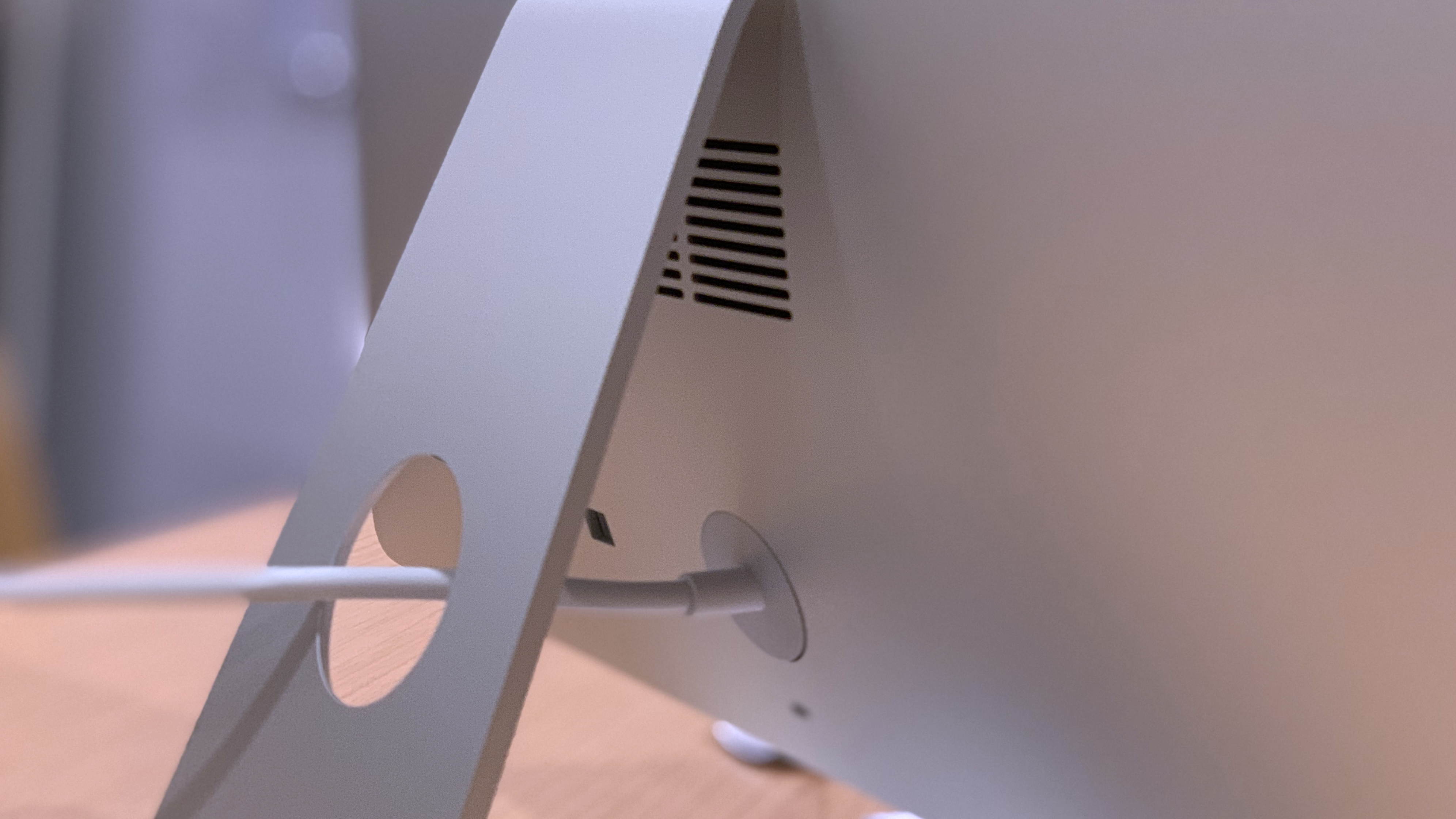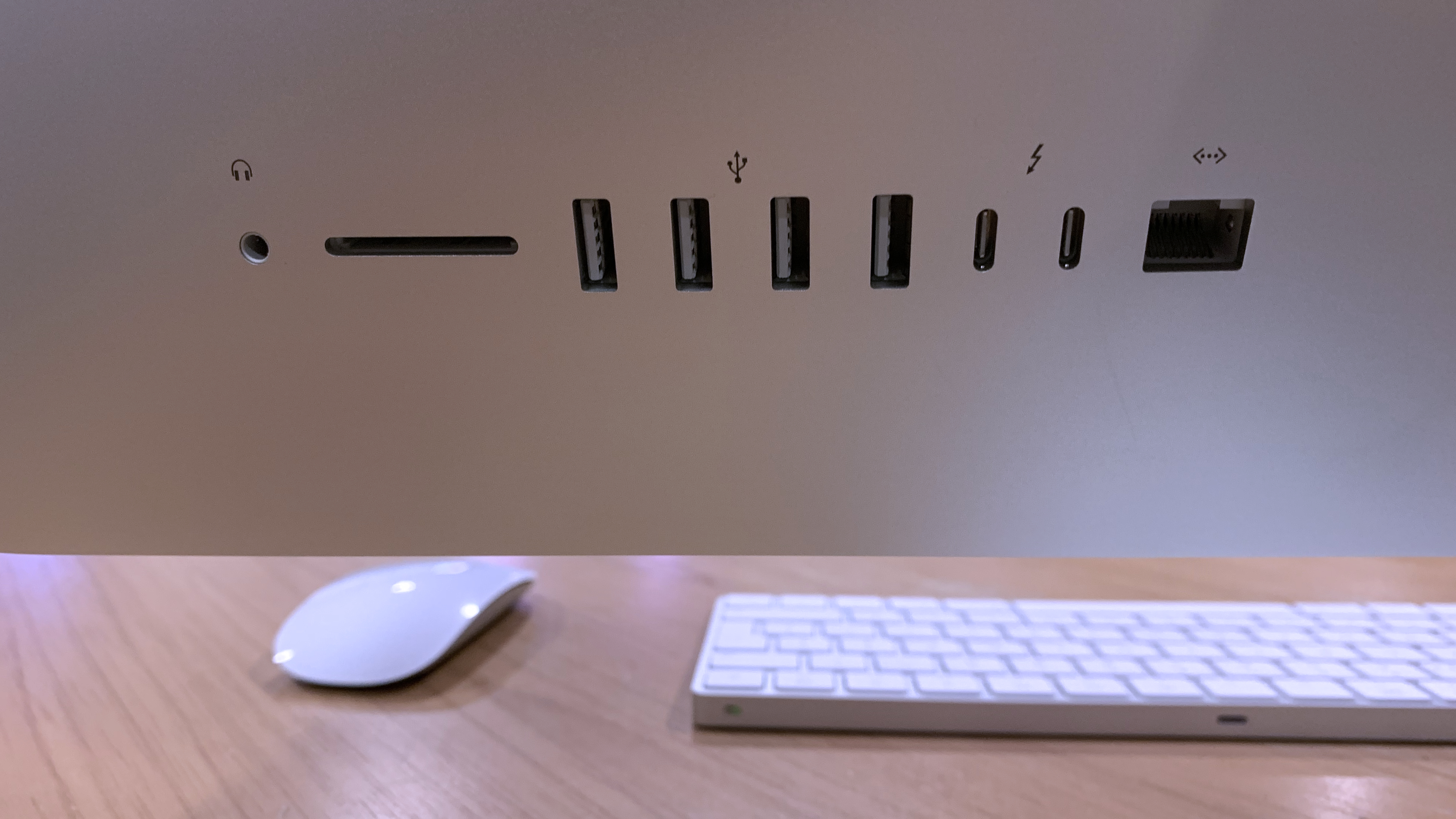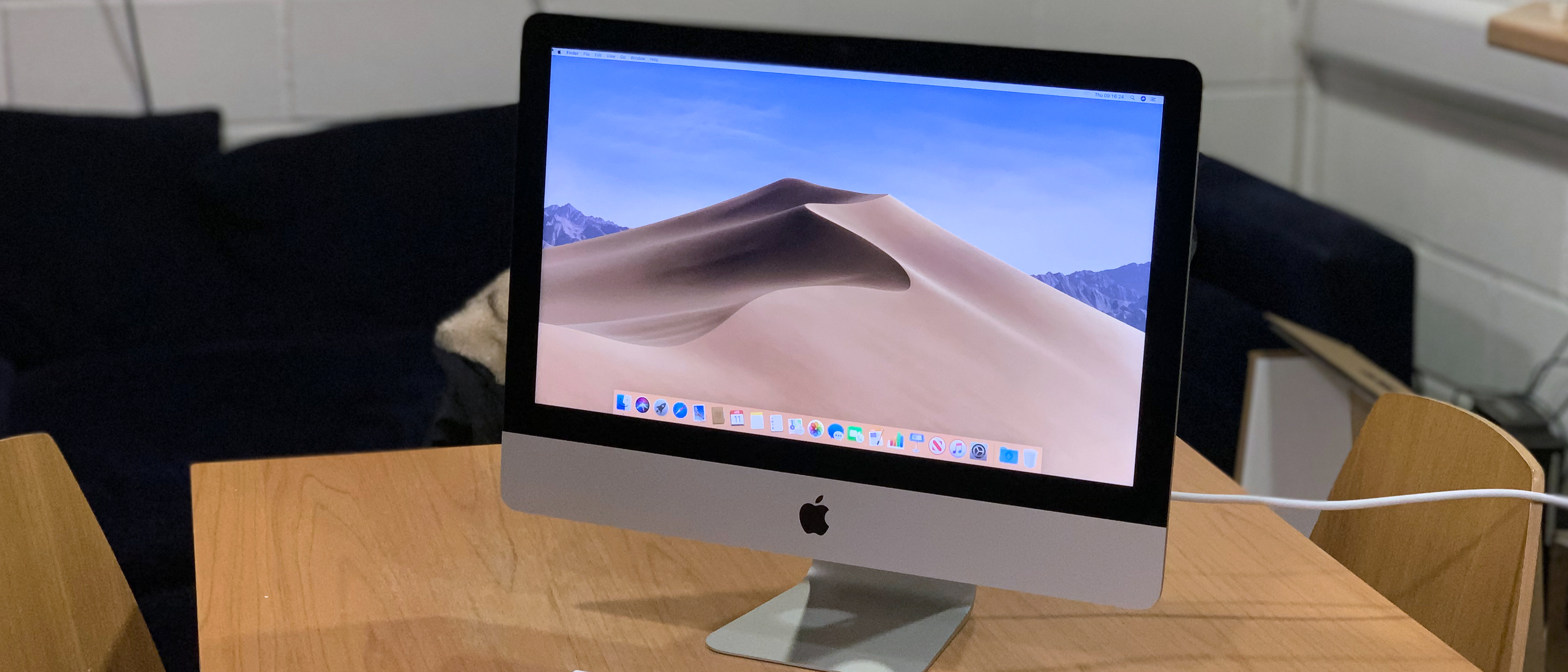Why you can trust TechRadar
With Intel’s chip line-up now comprised of four families – increasing in performance through i3, i5, i7 and i9 – this 21.5-inch iMac’s six-core i5 processor isn’t really expected to perform as well as the eight-core i9 that was in our 27-inch iMac.
Here’s how the Apple iMac (21.5-inch, 2019) performed in our suite of benchmark tests:
Cinebench R15 CPU: (single-core) 171.4 points, (multi-core) 937.8 points; Graphics: 108.2 fps
Cinebench R20 CPU: (single-core) 426 points, (multi-core) 2360.5 points
Geekbench 4: 5,321 (single-core); 20,690 (multi-core)
Rise of the Tomb Raider (High preset, 1,920 x 1080): 36.7 fps
Rise of the Tomb Raider (High preset, 4,096 x 2,304): 10.6 fps
Blackmagic Disk Speed Test (mean averages): (read) 534.1MB/sec, (write) 379.2MB/sec
Blackmagic Disk Speed Test (peak transfer rates): (read) 1.4GB/sec, (write) 850.5MB/sec
In HandBrake, the larger iMac churned through converting a video to HEVC format, a very intensive task, in 43 minutes and 56 seconds – standing out for taking less time than the video’s 57-minute duration. It’s also less than half the time taken by last year’s 13-inch MacBook Pro, which was packed with a 2.7GHz quad-core i7 (1 hour and 32 minutes).
We expected our 21.5-inch iMac’s 3.0GHz six-core i5 to finish somewhere around the same time as that MacBook Pro. The good (and unexpected) news is that it completed the task faster in only 1 hour and 8 minutes, a result much closer to its 27-inch counterpart than we were expecting.
There’s no Core i9 option on the 21.5-inch iMac, sadly. But, you can get a 3.2GHz Core i7 on either of the new configurations. It’s $200 (£180/AUS$320) more on the top model, and $300 (£270/AUS$460) more on the lower one.
We, however, haven’t tested this processor, so we can’t really say for sure just how much closer a 21.5-inch iMac’s capability is to that of the 27-inch iMac with Core i9’s performance when tackling tasks like this one.
Much ado about memory
If you’ve read our review of the newest 27-inch iMac, which went live just before this one, you’ll most likely already know some of what we have to say about the 21.5-inch iMac’s RAM.
Across the board, you get 8GB of DDR4 memory as standard, the clock speed of which Apple has bumped up to 2,666MHz this year. That amount is suitable for basic tasks, but on the 21.5-inch iMac you have a pressing choice to make.
Sign up for breaking news, reviews, opinion, top tech deals, and more.
Unlike the 27-inch iMac, a noteworthy disadvantage on the smaller version is that there’s no panel on the back through which to perform an easy RAM upgrade at home.
We’re waiting to see iFixit’s findings on how Apple has arranged the innards of the new 21.5-inch iMac. On the 2017 version, iFixit recorded a 64-step RAM upgrade process that involves screen, screws, circuit board and hard disk removal.
Even if it turns out Apple has kept that setup, rather than soldering the memory onto the logic board, the upgrade process is still best left to a service provider. That is, unless you happen to have access to a dust-free environment and all the necessary tools, and don’t mind a much greater risk to your warranty than when upgrading Apple’s larger all-in-one.
To upgrade the RAM to 16GB, you’ll have to spend another $200 (£180/AUS$320). Things start to get expensive at this point. Upgrading the higher-spec 21.5-inch iMac with a 256GB SSD and 16GB RAM ups the price to $1,799 (£1,719/AUS$2,799).
That’s not far off the base 27-inch iMac price with a 256GB SSD added, which gives you the freedom to effortlessly increase the memory beyond 8GB later, should you choose it’s essential.
Most people won’t have to go beyond 16GB, however. Apple will install up to 32GB of RAM in a 21.5-inch iMac – for $600 (£540/AUS$960). If you need more, ask an authorized service provider whether it will install memory bought by you. One we asked confirmed it would, but that it couldn’t offer a warranty for the work.

Storage woes
In terms of storage, the lower-cost 21.5-inch iMac has a 1TB hard disk, while the more expensive one comes with a 1TB Fusion Drive.
On the former, you’ll drop an additional $100 (£90/AU$160) to swap in a 1TB Fusion Drive. However, we’re no longer fans of Apple’s current Fusion Drives, and strongly advise against getting any iMac with one fitted.
A Fusion Drive augments a hard disk with a small amount of SSD storage, and pairs the two at the software level to make them appear like one drive in macOS. Behind the scenes, macOS works out – not just once, but consistently – what data you use most often. It tries to keep your most-used blocks of data, which doesn’t necessarily mean whole files, on the SSD portion of the Fusion Drive. As that fills up, it sends what it thinks you won’t need soon to the hard drive, the goal being to keep some of the faster storage medium available for immediate use by the system and apps.
The trouble is Apple altered the make-up of Fusion Drives a few years after their 2012 debut. Back then, Apple used 128GB SSDs, but has since cut that to 24GB or 32GB. Apple appears to have somewhat changed its specifications for 1TB Fusion Drives again, though at least in a direction that looks like an improvement if you consider a slightly bigger number to be better. Lower capacity Fusion Drives used to include just a 24GB SSD, but our 2019 unit contains 32GB.
That 8GB makes very little difference in the long term, unfortunately. We mentioned already that the Fusion Drive tech frequently updates its decisions about what’s stored where.
Blackmagic’s Disk Speed Test gives a good idea of sustainable transfer rates. It exposed the limitation in the Fusion Drive’s performance once we put enough data onto the iMac so that it was having to use the hard disk component.
Mean average read and write speeds of 534.1MB/sec and 379.2MB/sec, respectively, are OK, and the SSD portion of the Fusion Drive surely did better. Much better in fact, peaking at 1.4GB/sec read and 850.5MB/sec write. The big gap between those maximum and mean average speeds highlights how compromised performance can get.
The 128GB SSD in early Fusion Drives could viably keep performance at an acceptable rate for a longer time. With that larger capacity, chances are good that your apps and recent documents would have remained on the SSD since you last used them.
In theory, data would even need to be moved around less frequently, though we don’t know what adjustments Apple has made to its algorithm at the same time as reducing the SSD’s capacity.
However, today’s Fusion Drives obviously don’t perform as well as hoped. So, our advice when buying an iMac – whether it’s a 21.5-inch or a 27-inch model – is to purchase it with the largest SSD capacity you can justify. However, note that things get expensive with the 512GB and 1TB options, which range from $300 to $800.

Pushing pixels and polygons
When it comes to graphical capability, our review 21.5-inch iMac’s Radeon Pro 560X – the better of the two stock options – is regrettably weak when rendering Rise of the Tomb Raider with its quality settings dialed up to max.
Even at 1,920 x 1,080, the 560X couldn’t summon a playable frame rate. Its overall score was a mere 11 frames per second (fps). So, with these two GPUs, be ready to decrease effects settings as well as resolution. When we chose this game’s high quality preset, the frame rate shot up to 36 fps, allowing a much more comfortable playing experience.
Achieving better graphics performance doesn’t mean upgrading all the way up to the top of the 27-inch iMac line-up and its Vega 48 upgrade. There’s a Vega 20 option that can be added to the top 21.5-inch model for $350 (£315/AUS$560). But, we haven’t been able to test one of these, so we can’t say for sure how differently it performs compared to the Radeon Pro 560X. Also, keep in mind that you can always connect an external GPU over Thunderbolt.
Should you just go mini?
Are you now thinking of considering alternatives? If you have a monitor, mouse and keyboard that you’re happy with, you could use them with a Mac mini. That Mac’s late 2018 update impressed us in several respects.
Well, not its graphics processor, although that can be fixed by connecting an external GPU via a Thunderbolt 3 port. (That’s also possible on other Macs, including the 21.5-inch iMac.)
The $799 (£799/AUS$1,249) Mac mini has a 128GB SSD by default. You’ll get double that capacity for an extra $200 (£180/AUS$320). It’s easy to get pulled in by the classic strategy of upselling, however.
The Mac mini also supports aftermarket memory upgrades, although you may want a service provider to do it for you like the 21.5-inch iMac. If you check out iFixit’s guide to upgrading the Mac mini, then you’ll see that it’s not as simple as the 2012 design, taking 22 steps rather than 3. (The 2014 Mac mini’s RAM was soldered in place.)
Final verdict
As noted earlier in this review and that of the 27-inch iMac, the real weakness of Apple’s consumer all-in-ones is the hard disk or Fusion Drive storage that’s included in the configurations. Everyone who wants to invest in an iMac will get much greater satisfaction from it by swapping that with an SSD of adequate size for their needs.
Even if you plan on putting the 21.5-inch iMac to light work, we recommend upgrading its RAM to 16GB as well. It’s not guaranteed, but because of the difficulty of even getting to the memory, that should help the iMac last longer before another upgrade is needed.
By the time you’ve refreshed those two parts, you’re getting quite a bit beyond whichever specification’s price you started with.
Unfortunately, Apple’s decision about memory upgradeability set the 21.5-inch iMac off to a disadvantaged start, particularly next to its larger sibling. If you just can’t accommodate a 27-inch iMac, your options are instantaneously limited.
Beyond those components, yes, the 21.5-inch iMac’s GPU options (except possibly the Vega 20 that we’ve been unable to test) aren’t very compelling, though they’re definitely capable of powering day-to-day work on the 4K display.
You may not even have the need for Intel processor and graphics upgrades. After all, this is the iMac best suited to light computer use. Still, having to consider getting by on 8GB of RAM and possibly learning it was a bad choice is an uncomfortable place to be when hovering over the ‘Buy’ button.
Get the choice right, and you’ll be very content with the 21.5-inch iMac. Get it wrong, though, and you may end up resenting the fact that you didn’t get the SSD upgrade at the very least. If you add nothing else to the spec, do add that. Without it, we find this year’s 21.5-inch iMac too dependent upon upgrades at checkout to fully recommend.
